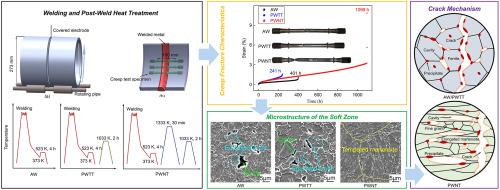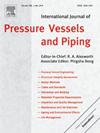通过稳定回火马氏体结构提高 P91 钢焊接件的蠕变寿命
IF 3
2区 工程技术
Q2 ENGINEERING, MECHANICAL
International Journal of Pressure Vessels and Piping
Pub Date : 2024-11-14
DOI:10.1016/j.ijpvp.2024.105361
引用次数: 0
摘要
P91 钢焊接件在高温服役期间容易出现 IV 型蠕变裂纹,从而大大降低受影响部件的蠕变寿命。为提高 P91 钢焊接件的蠕变寿命,本研究提出了一种新型焊后热处理策略,以稳定回火马氏体结构,避免 IV 型蠕变裂纹。与传统的焊后回火处理焊件相比,焊接后焊件的蠕变寿命提高了 1.7 倍,而经过焊后正火再回火处理的焊件的蠕变寿命提高了 4.6 倍,有效防止了 IV 型裂纹的产生。研究发现,在焊接后的焊件和焊接后回火处理的焊件中会出现蠕变薄弱区,即软区,其微观结构主要是再结晶铁素体。蠕变断裂总是发生在再结晶晶粒比例最高的区域。焊后正火和随后的回火可提高奥氏体晶粒尺寸并稳定回火马氏体结构。对于焊接后的焊接件和焊接后回火处理的焊接件,蠕变空穴会沿着铁素体晶界生长,而不是之前的奥氏体晶界,这很容易导致晶间过早开裂。在焊后正火和随后的回火焊接中,空穴沿着母材之前的奥氏体晶界形成,并在应力作用下与马氏体包/块一起伸长。最后,拉长的晶粒破裂导致最终断裂。本文章由计算机程序翻译,如有差异,请以英文原文为准。

Enhanced creep lifetime in P91 steel weldments via stabilizing tempered martensite structure
P91 steel weldments are susceptible to Type IV creep cracking during high-temperature service, significantly reducing the creep lifetime of impacted components. For enhancing the creep lifetime of P91 steel weldments, the present work proposes a novel post-weld heat treatment strategy to stabilize the tempered martensite structure and avoid Type IV creep cracking. Compared to conventional post-weld tempered treatment weldments, the creep lifetime of as-welded weldment is improved by 1.7 times, while the creep lifetime of weldment subjected to post-weld normalizing followed by tempering is enhanced by 4.6 times, effectively preventing Type IV cracking. It has been revealed that creep weakness zones, that is, soft zones, occur in as-welded weldment and post-welded tempering treatment weldment, where the microstructure is predominantly recrystallized ferrites. Creep fracture always occurs in the region of the highest fraction of recrystallized grains. Post-weld normalizing and subsequent tempering can enhance prior austenite grain size and stabilize tempered martensite structure. For as-welded weldment and post-welded tempering treatment weldment, creep cavities preferentially grow along ferrite grain boundaries as compared to prior austenite grain boundaries, which could easily lead to intergranular premature cracking. For post-weld normalizing and subsequent tempering weldment, cavities form along prior austenite grain boundaries of base metal and are elongated together with martensitic packets/blocks under stress. Finally, the final fracture is caused by the rupture of elongated grains.
求助全文
通过发布文献求助,成功后即可免费获取论文全文。
去求助
来源期刊
CiteScore
5.30
自引率
13.30%
发文量
208
审稿时长
17 months
期刊介绍:
Pressure vessel engineering technology is of importance in many branches of industry. This journal publishes the latest research results and related information on all its associated aspects, with particular emphasis on the structural integrity assessment, maintenance and life extension of pressurised process engineering plants.
The anticipated coverage of the International Journal of Pressure Vessels and Piping ranges from simple mass-produced pressure vessels to large custom-built vessels and tanks. Pressure vessels technology is a developing field, and contributions on the following topics will therefore be welcome:
• Pressure vessel engineering
• Structural integrity assessment
• Design methods
• Codes and standards
• Fabrication and welding
• Materials properties requirements
• Inspection and quality management
• Maintenance and life extension
• Ageing and environmental effects
• Life management
Of particular importance are papers covering aspects of significant practical application which could lead to major improvements in economy, reliability and useful life. While most accepted papers represent the results of original applied research, critical reviews of topical interest by world-leading experts will also appear from time to time.
International Journal of Pressure Vessels and Piping is indispensable reading for engineering professionals involved in the energy, petrochemicals, process plant, transport, aerospace and related industries; for manufacturers of pressure vessels and ancillary equipment; and for academics pursuing research in these areas.

 求助内容:
求助内容: 应助结果提醒方式:
应助结果提醒方式:


